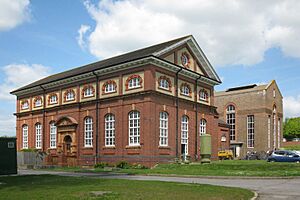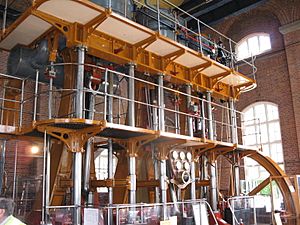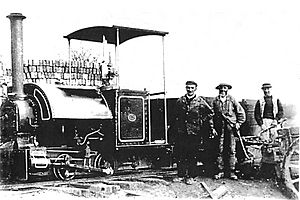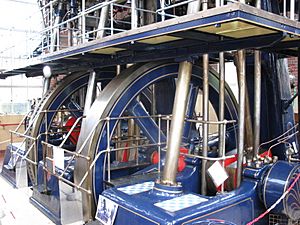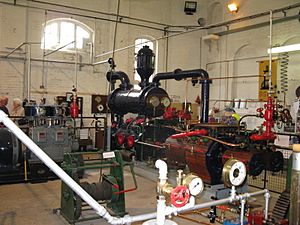Brede Waterworks facts for kids
Brede Waterworks is a special place in Brede, East Sussex, England. It was built a long time ago to give clean drinking water to the town of Hastings. This waterworks still has two big steam engines. These engines used to pump water from Brede all the way to large storage tanks, called reservoirs, in places like Fairlight and Baldslow.
Contents
Why Brede Waterworks Was Built
In the 1890s, the town of Hastings needed more and more water. People looked at different places to get this water. One idea was a site at Glynde, which had been considered before. Another option was West Dean.
However, a local councillor named Thomas Elworthy had a different idea. He was also a geologist, someone who studies rocks and the Earth. He suggested Brede because it was closer to Hastings. This would make building the water system less expensive.
In 1897, Hastings bought Church House Farm in Brede. They dug three deep wells to find water. Two wells are about 275 feet (84 meters) deep. The third well is about 200 feet (61 meters) deep. A pumping station was built to hold a steam engine. This engine pumped water from the wells to a big reservoir at Fairlight. Brede Waterworks officially opened in 1904.
The Brede Tramway
Building the waterworks was a huge job. To help move materials, a small railway, called a tramway, was built. It had a narrow track, only 18 inches wide. The tramway ran from a dock on the River Brede right to the waterworks.
A steam locomotive pulled the building materials. There were also four wagons that could carry three tons each. Once the waterworks was finished, the tramway and its locomotive stayed. They were used to bring coal from the dock to the waterworks. This coal was needed to power the boilers for the steam engines. Sometimes, a pony pulled the wagons if the steam locomotive wasn't working.
Even though it wasn't for the public, important people from Hastings sometimes rode the tramway. They would sit on straw or sacks in the open wagons.
In the 1920s, the River Brede became too shallow for boats. So, that part of the tramway was no longer used. Coal then came from Doleham Halt by train. A new road was built to the waterworks, and the tramway closed around 1937. The tracks were later removed. After that, coal was delivered by lorries (trucks) directly to the waterworks. In 1964, electric pumps took over from the steam engines, and the old boilers were removed.
The Tramway Locomotive
The steam locomotive used on the tramway was built in 1899 by a company called Bagnall. It was named Brede when it was new. In 1923, it got a new boiler. Around 1931, the locomotive was rebuilt because its water tanks needed replacing. The locomotive was taken out of service in 1935 because it was worn out. It was later scrapped.
The Original Building
The first waterworks building was designed in a style called Baroque. Inside, it held two very powerful steam engines. These engines were built by Tangye of Birmingham. They were powered by four large boilers made by Babcock & Wilcox from the United States. One of these engines was removed in 1969. However, the second one has been fixed up and can be seen today. This building is considered a special historical building.
The Worthington-Simpson Building
In 1939, a new building was added. It was built in the Art Deco style, which was popular at the time. This building houses another large steam engine. It was built in 1940 by Worthington-Simpson. At this time, the four old boilers were replaced with two new ones. The new building was finished in 1942.
The Engines
Engine No. 1
Engine No. 1 was exactly like Engine No. 2. It was removed in 1969.
Engine No. 2
Engine No. 2 was built by Tangye in 1904. It is a very strong engine, about 410 horsepower. It could pump 3.5 million gallons (15.9 million liters) of water every day. It lifted the water up to a height of 515 feet (157 meters). This engine supplied water to the reservoirs at Fairlight and Baldslow.
The Worthington-Simpson Engine
This engine was built by Worthington-Simpson in 1940. It was the last engine of its kind that Worthington-Simpson ever made.
The Boiler House
The boiler house originally had four Babcock & Wilcox boilers. These were replaced in 1940 with two new Babcock & Wilcox boilers. These new boilers were removed in 1964. Today, the boiler house displays different steam engines and exhibits that show how water is supplied.
See also


